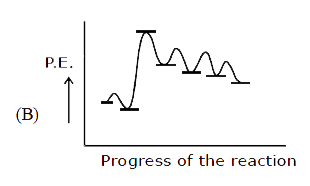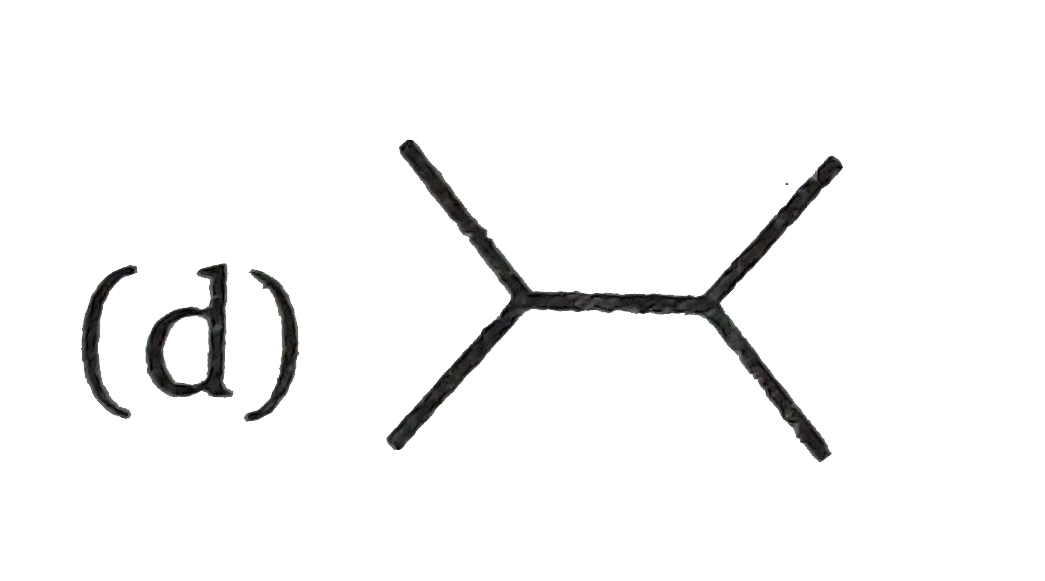CH3−CH3∣C∣OH−CH3∣C∣OH−CH3H+−−→Δ(P) (Major)
Major product (P) is :
CH−O∣∣C−CH3∣C∣CH3−CH3
CH3=CH3∣C−CH3∣C−CH3

CH3−O∣∣C−CH3
The correct Answer is:A
To solve the problem, we need to analyze the chemical reaction involving the given compound and determine the major product (P) formed after the reaction with H+ under heat (Δ). The compound can be represented as follows:
Structure of the Compound:
- The compound consists of two hydroxyl (OH) groups attached to a carbon chain with methyl (CH3) groups.
1. Identify the Structure:
The compound can be represented as:
CH3−CH(OH)−C(OH)−CH3
This indicates that we have a symmetrical compound with two hydroxyl groups.
2. Protonation of Hydroxyl Groups:
When the compound reacts with H+, one of the hydroxyl groups (OH) will get protonated, forming a better leaving group (water, H2O):
CH3−CH(OH+2)−C(OH)−CH3
Here, the OH group becomes OH2+, making it a good leaving group.
3. Formation of Carbocation:
The protonated hydroxyl group leaves, resulting in the formation of a carbocation:
CH3−CH+−C(OH)−CH3+H2O
This carbocation is formed at the carbon where the OH group was initially located.
4. Methyl Shift:
A methyl group from the adjacent carbon will migrate to the carbocation center to stabilize it:
CH3−CH+−C(OH)−CH3→CH3−CH(CH3)−C+−CH3
This results in a more stable tertiary carbocation.
5. Formation of the Major Product:
The final step involves the deprotonation of the hydroxyl group, leading to the formation of a double bond (alkene):
CH3−C(CH3)=C(OH)−CH3
After the loss of H+, we get the major product:
CH3−C(CH3)=C(CH3)−CH3
Conclusion:
The major product (P) formed from the reaction is:
Major Product (P):CH3−C(CH3)=C(CH3)−CH3
- The compound consists of two hydroxyl (OH) groups attached to a carbon chain with methyl (CH3) groups.
The compound can be represented as:
CH3−CH(OH)−C(OH)−CH3
This indicates that we have a symmetrical compound with two hydroxyl groups.
When the compound reacts with H+, one of the hydroxyl groups (OH) will get protonated, forming a better leaving group (water, H2O):
CH3−CH(OH+2)−C(OH)−CH3
Here, the OH group becomes OH2+, making it a good leaving group.
The protonated hydroxyl group leaves, resulting in the formation of a carbocation:
CH3−CH+−C(OH)−CH3+H2O
This carbocation is formed at the carbon where the OH group was initially located.
A methyl group from the adjacent carbon will migrate to the carbocation center to stabilize it:
CH3−CH+−C(OH)−CH3→CH3−CH(CH3)−C+−CH3
This results in a more stable tertiary carbocation.
The final step involves the deprotonation of the hydroxyl group, leading to the formation of a double bond (alkene):
CH3−C(CH3)=C(OH)−CH3
After the loss of H+, we get the major product:
CH3−C(CH3)=C(CH3)−CH3
The major product (P) formed from the reaction is:
Major Product (P):CH3−C(CH3)=C(CH3)−CH3
Topper's Solved these Questions
- ALCOHOLS & ETHERSBOOK - MOTIONCHAPTER - ALCOHOLS & ETHERSEXERCISE - EXERCISE -2 (LEVEL -II) MULTIPLE CORRECT JEE ADVANCED
21 Videos
- ALCOHOLS & ETHERSBOOK - MOTIONCHAPTER - ALCOHOLS & ETHERSEXERCISE - EXERCISE -3 OBJECTIVE PROBLEMS JEE ADVANCED
17 Videos
- ALCOHOLS & ETHERSBOOK - MOTIONCHAPTER - ALCOHOLS & ETHERSEXERCISE - EXERCISE -1 OBJECTIVE PROBLEMS JEE MAIN
47 Videos
- ALKYI HALIDEBOOK - MOTIONCHAPTER - ALKYI HALIDEEXERCISE - Exercise - 4 | Level-II
8 Videos
Similar Questions
Knowledge Check
CH3−OH∣C∣H−CN is
AAcetaldehyde cyanohydrinBAcetone cyanohydrinCCyanoethanolDEthanol nitrilePh−Ph∣C∣H−H∣C∣CH3−CH2−OHH+−−→Δ Product
Select the correct P.E. graph for major product.A B
B C
C DNone
DNoneCH3−CH3∣C∣CH3−C∣BrH−CH3nderset(Δ)EtOH−−−→(A)
Major product (A) is:A B
B C
C D
D
